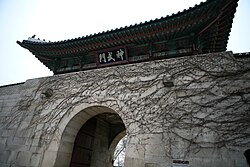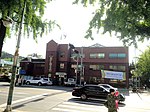Blue House

Cheong Wa Dae (Korean: 청와대; Hanja: 靑瓦臺; lit. 'Cyan-tile Pavilion'), also known as the Blue House, was the executive office and official residence the president of South Korea, located in Jongno-gu of the capital Seoul. Cheong Wa Dae is in fact a complex of multiple buildings, built largely in the traditional Korean architectural style with some modern architectural elements and facilities. The Blue House was one of the most protected official residences in Asia. Upon the inauguration of president Yoon Suk-yeol in May 2022, Cheong Wa Dae was relieved of its duties as the official residence and executive office of the president and was fully converted to a public park. Built upon the site of the royal garden of the Joseon Dynasty (1392–1910), Cheong Wa Dae now consists of the Main Office Hall Bon-gwan (Korean: 본관; Hanja: 本館; lit. "Main House"), the Presidential Residence, the State Reception House Yeongbin-gwan (Korean: 영빈관; Hanja: 迎賓館; lit. "Welcome-Guest House"), the Chunchu-gwan (Korean: 춘추관; Hanja: 春秋館; lit. "Spring-Autumn House") Press Hall, and the Secretariat Buildings. The entire complex covers approximately 250,000 square metres or 62 acres.
Excerpt from the Wikipedia article Blue House (License: CC BY-SA 3.0, Authors, Images).Blue House
Samcheong-ro 7-gil, Seoul
Geographical coordinates (GPS) Address Nearby Places Show on map
Geographical coordinates (GPS)
| Latitude | Longitude |
|---|---|
| N 37.5867 ° | E 126.9763 ° |
Address
관저
Samcheong-ro 7-gil
03054 Seoul
South Korea
Open on Google Maps







